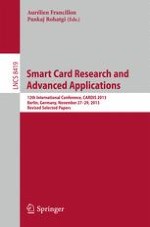2014 | Buch
Smart Card Research and Advanced Applications
12th International Conference, CARDIS 2013, Berlin, Germany, November 27-29, 2013. Revised Selected Papers
herausgegeben von: Aurélien Francillon, Pankaj Rohatgi
Verlag: Springer International Publishing
Buchreihe : Lecture Notes in Computer Science
